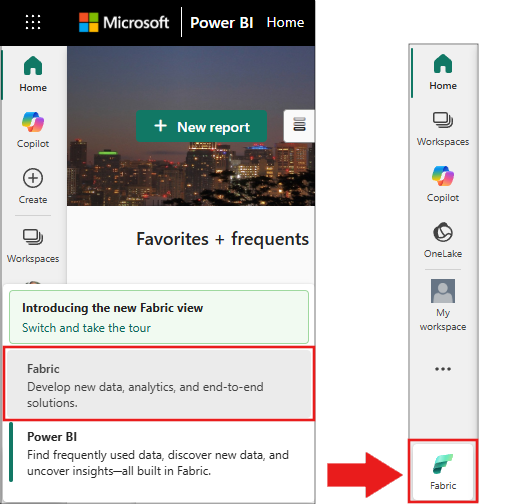重要
此功能目前为预览版。
Azure AI 翻译是一项 Azure AI 服务,可用于执行语言翻译和其他与语言相关的操作。
此示例演示如何在 Fabric 中使用预构建的 Azure AI 翻译器和 RESTful API:
- 翻译文本
- 直译文本
- 获取支持的语言
先决条件
获取 Microsoft Fabric 订阅。 或者注册免费的 Microsoft Fabric 试用版。
登录到 Microsoft Fabric。
使用主页左下侧的体验切换器切换到 Fabric。

- 创建新的笔记本。
- 将笔记本附加到湖屋。 在笔记本的左侧,选择 添加 来添加已有的湖仓或创建一个新的湖仓。
注释
本文使用 Microsoft Fabric 的内置预生成 AI 服务,这些服务会自动处理身份验证。 无需获取单独的 Azure AI 服务密钥 - 身份验证是通过 Fabric 工作区管理的。 有关详细信息,请参阅 Fabric 中的预生成 AI 模型(预览版)。
本文中的代码示例使用预安装在 Microsoft Fabric 笔记本中的库:
-
SynapseML:预安装在 Fabric 笔记本中,用于机器学习功能
-
synapse.ml.core- 核心 SynapseML 功能 -
synapse.ml.fabric.service_discovery- Fabric 服务发现实用工具 -
synapse.ml.fabric.token_utils- 身份验证令牌实用工具 -
synapse.ml.services- AI 服务集成(包括 Translate、Transliterate 类)
-
-
PySpark:默认情况下在 Fabric Spark 计算中可用
-
pyspark.sql.functions- 数据帧转换函数 (col,flatten)
-
-
标准 Python 库:内置于 Python 运行时
-
json- JSON 分析和格式设置 -
requests- 用于 REST API 调用的 HTTP 客户端
-
# Get workload endpoints and access token
from synapse.ml.fabric.service_discovery import get_fabric_env_config
from synapse.ml.fabric.token_utils import TokenUtils
import json
import requests
fabric_env_config = get_fabric_env_config().fabric_env_config
auth_header = TokenUtils().get_openai_auth_header()
# Make a RESTful request to AI service
prebuilt_AI_base_host = fabric_env_config.ml_workload_endpoint + "cognitive/texttranslation/"
print("Workload endpoint for AI service: \n" + prebuilt_AI_base_host)
service_url = prebuilt_AI_base_host + "language/:analyze-text?api-version=2022-05-01"
print("Service URL: \n" + service_url)
auth_headers = {
"Authorization" : auth_header
}
def print_response(response):
print(f"HTTP {response.status_code}")
if response.status_code == 200:
try:
result = response.json()
print(json.dumps(result, indent=2, ensure_ascii=False))
except:
print(f"pasre error {response.content}")
else:
print(f"error message: {response.content}")
文本翻译
文本翻译是翻译服务的核心工作。
service_url = prebuilt_AI_base_host + "translate?api-version=3.0&to=fr"
post_body = [{'Text':'Hello, friend.'}]
response = requests.post(service_url, json=post_body, headers=auth_headers)
# Output all information of the request process
print_response(response)
输出
HTTP 200
[
{
"detectedLanguage": {
"language": "en",
"score": 1.0
},
"translations": [
{
"text": "Bonjour cher ami.",
"to": "fr"
}
]
}
]
文本音译
音译根据拼音相似性将一种语言的脚本(字母)中的单词或短语转换为另一种语言。
service_url = prebuilt_AI_base_host + "transliterate?api-version=3.0&language=ja&fromScript=Jpan&toScript=Latn"
post_body = [
{"Text":"こんにちは"},
{"Text":"さようなら"}
]
response = requests.post(service_url, json=post_body, headers=auth_headers)
# Output all information of the request process
print_response(response)
输出
HTTP 200
[
{
"text": "Kon'nichiwa",
"script": "Latn"
},
{
"text": "sayonara",
"script": "Latn"
}
]
支持的语言检索
返回翻译器支持的语言列表。
service_url = prebuilt_AI_base_host + "languages?api-version=3.0"
response = requests.get(service_url, headers=auth_headers)
# Output all information of the request process
print_response(response)